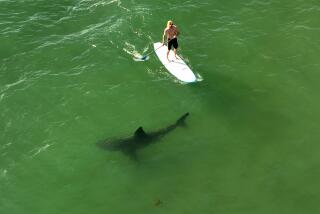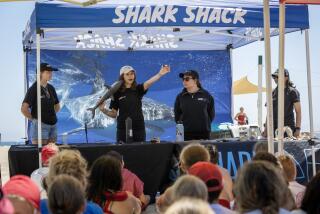Where sharks (and other predators) lurk
Durban, South Africa â I came to Durban in February about the same time that âJawsâ author Peter Benchley died, but thatâs not the only reason sharks and Durban go together in my mind.
The city on the Indian Ocean, which has about 2.5 million residents, once was plagued by shark attacks, peaking in the summer (our winter) of 1957-58, when there were six in 100 days.
Like almost everybody who read Benchleyâs bestseller and saw the 1975 blockbuster movie, I am strangely compelled by the torpedo-shaped marine predators. They can smell prey from more than half a mile away, and in some species, their multiple rows of sharp teeth, when lost, grow back in a matter of weeks.
When I discovered that Durbanâs 60-mile-long coast is lined with nets maintained by the Natal Sharks Board (www.shark.co.za) and that the organization offers tours and shark dissections, I decided I had to come to South Africaâs third-largest city.
Durban isnât an international tourist destination, but its beaches attract throngs of South Africans. I was on my way to a game reserve about 400 miles north of Durban, so it was on the way. No one thought it odd that I wanted to see lions and rhinos, but when I told people I planned to attend a shark dissection, their eyes narrowed. And people who had been to South Africa warned me about crime, statistically far more threatening than shark attacks.
Armed robbery, murder, rape and carjacking reached a high in South Africa in the late â90s, especially in its big cities. Since then crime has declined a bit. Between 2001 and 2005, car theft and murder dropped 12% to 13%.
Still, I carried my valuables in a concealed pouch and booked a hotel in the ritzy, presumably safe suburb of Umhlanga Rocks, home of the Natal Sharks Board, 10 miles north of downtown.
Beachy Umhlanga Rocks reminded me of Santa Monica, except that the houses seemed a virtual Ft. Knox. They were protected by fences, gates, barbed wire and high-tech security systems. Hotels, shopping centers and condominium complexes all had guards.
Because I hadnât rented a car and bus service was limited, getting around was going to be a problem. For dinner that night, I had to take a taxi to the Gateway Mall in Umhlanga Rocks and its 290 shops and restaurants, simulated wave pool for surfers and two-story rock-climbing wall.
The next morning I gave in and rented a car, then stopped at the Umhlanga Rocks tourist office. With no cue from me, two information specialists told me it wasnât safe to drive downtown alone but that if I did I shouldnât leave anything in the car.
That put a damper on my enjoyment of Durban, though my visit to the Natal Sharks Board taught me about the most dangerous shark species -- great whites, Zambezis and tigers.
Sharks used to follow whaling vessels into the Durban harbor. But attacks have dramatically diminished since the â60s, when the Natal Sharks Board placed about 16 miles of netting along the coast, and since the whaling industry was closed down in 1976.
Thanks to the boardâs efforts, most Durban water lovers know to stay out of the surf in the early morning and at night, when sharks are most active; to avoid wearing shiny jewelry and brightly colored bathing suits; to keep away from murky water; and to swim in groups so help is always close at hand. There have been only two serious shark attacks in the 21 years at netted beaches along Durbanâs coast.
It would seem, in fact, that sharks are now in more danger than people. A 2004 study at Dalhousie University in Halifax, Nova Scotia, found a 90% decline in large predatory fish worldwide. Benchley himself advocated shark protection, telling the London Daily Express just a few days before he died, â âJawsâ was entirely a fiction. Knowing what I know now, I could never write that book today.â
The Natal Sharks Board has been considering the removal of some of the netting, because many of the sharks, rays, dolphins and sea turtles that get trapped die before they can be released. NSB boats go out almost daily to check the nets.
One such was a 6-foot black-tipped shark that came out of the boardâs freezer for the dissection I attended along with a passel of excited grade-school kids. They clapped and cheered when speaker Debbie Hargreaves opened the demonstration by saying, âNow Albert is going to start cutting this shark open. Weâll see if thereâs anything nice and interesting inside.â
Sharksâ stomachs sometimes contain an array of interesting objects, but this one was clean.
Later I saw live sharks swimming in a tank at uShaka Marine World on the harbor in downtown Durban. The park has an aquarium in an ersatz shipwreck, water slides, dolphin shows and inner-tube rides. But the area around it is run-down, though slated for redevelopment.
I went to the Indian market and botanic gardens near the city center, then drove north to see wilder sections of the coast, all without incident.
But in the parking lot at an Umhlanga Rocks shopping mall on my last night in town, I heard a young man screaming at a cowering security guard, âI had a new SUV with a lock on the steering wheel and now itâs gone. Didnât you see it getting stolen?â
That, alas, is my lasting impression of Durban. I think of that, not âJaws,â whenever I see the little souvenir collection of sharksâ teeth I bought at the Natal Sharks Board.
More to Read
Sign up for The Wild
Weâll help you find the best places to hike, bike and run, as well as the perfect silent spots for meditation and yoga.
You may occasionally receive promotional content from the Los Angeles Times.






